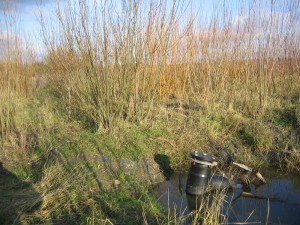Using Short Rotation Coppice (SRC) willows for bioremediation of contaminated sites

Short rotation coppice (SRC) planted on a landfill site. A gas well to extract landfill gas is in the foreground.
Short Rotation Coppice (SRC) willow is widely known to be a useful means of remediating contaminated land. This is achieved through a number of processes taking place within the soil and by the uptake of nutrient and harmful chemicals into the wood which is removed during harvest and the improvement of the soil through the donation of significant quantities of leaf litter and root biomass. Over the 20-30 year timeframe of a plantation the offtake of contaminants will lead to lower levels of contamination and prevent leaching of nitrogen, phosphorous and heavy metals into nearby watercourses.
Our SRC contaminated land table indicates typical values for certain chemicals in willow woodchip. The table also shows the amount of these chemicals and heavy metals that could potentially be removed from a site based on the suggested nutrient recommendations for SRC and research results where willow has been planted on contaminated sites. In the case of the latter, the mean results for Cadmium, Copper, Nickel and Zinc removal are based on varieties like Terra Nova that were able to accumulate heavy metals whilst achieving high yields.
Based on this analysis a 20 hectare SRC plantation could remove significant quantities of nutrients and heavy metals. Over 22 years (7 harvests) the SRC could remove between 16-36 tonnes of Nitrogen and 2-5 tonnes of Phosphorous. An SRC plantation could therefore help prevent these chemicals leaching into local water courses causing eutrophication.
Significant quantities of cadmium, zinc and copper could also be removed from the site. The removal of cadmium is particularly important as this heavy metal is associated with osteoporosis and increased levels of bone fractures when ingested through food crops.
If soil tests indicate that the soil is highly contaminated with heavy metals then the willow chip produced may need to be blended with woodchip from other virgin sources to reduce the contaminants in the chip. Following combustion, heavy metals tend to remain in the grate and fly ash which is caught by cyclones (on heat exchangers) of the boiler. If the SRC chip is blended then the fly ash can be used as a fertiliser and returned to land. If SRC woodchip is used exclusively in the boiler and the concentrations of cadmium and other heavy metals are high then the fly ash may need to be disposed of by a specialised waste contractor.
- SRC willow could therefore bring a multitude of benefits:
- Income from woodchip sales
- A green solution to a problem site
- Increased Carbon sequestration and biodiversity benefits
- Removal of contaminants from the land therefore potentially allowing the site to be used for conventional agricultural production or sold for development
- Reducing the impact of the site on local water courses
- Covering the land providing an evapotranspiration cap reducing leachate and also reducing the potential for fly tipping
If you own or manage a contaminated site and would like to discuss options for its management using SRC then please give us a call.